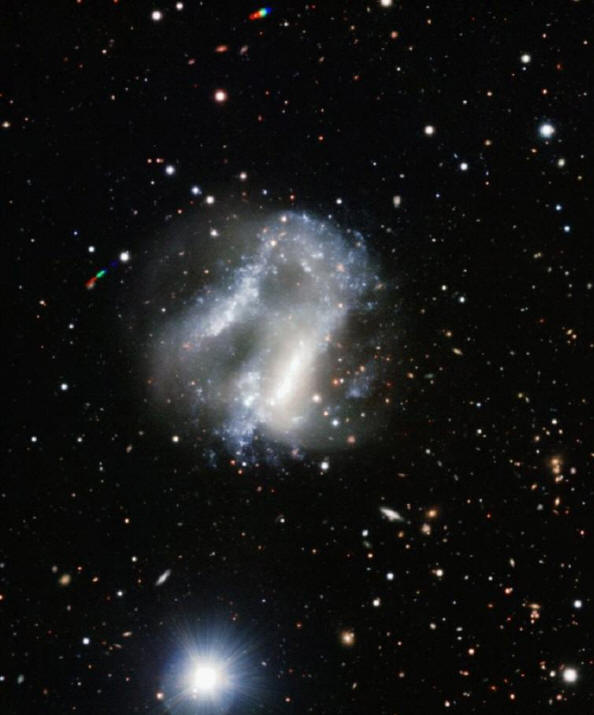|
|
A Lamentation for Arp 261
Mar
20, 2009
ESO has released another image of
another instance of standard-theory
hermeneutics. The several space
bureaucracies have become adept at
discovering peculiar celestial
objects that send them back to the
drawing board only to draw the same
idea again.The
press release begins with a
spark of curiosity: “Sometimes
objects in the sky that appear
strange, or different from normal,
have a story to tell and prove
scientifically very rewarding. This
was the idea behind Halton Arp’s
catalogue of Peculiar Galaxies
that appeared in the 1960s.”
The press release neglects to
mention that one reward of Arp’s
catalog was the questioning of the
expanding universe hypothesis—a
challenge that was suppressed by the
political
prohibition of questioning
established answers.
The press release remarks that
“...the image proves to contain
several surprises,” but this soon
proves to be only a rhetorical
remark: The next paragraph sweeps
the surprise into the standard bin
of “colliding
galaxies” before anyone’s pulse
can get in a faster beat. Curiosity
is soothed back into unquestioning
somnolence by parroting approved
answers. That makes for a short
press release, so the piece is
filled out with repetitions of
standard repetitiousness about
supernovae and stars.
What if curiosity were not
patronized into conformity? What if
the questions were encouraged to
explore the surprises in defiance of
the answers who seek to constrain
vision with their tunnels of
acceptability? What else could Arp
261 be?
Instead of “clouds of gas and dust”
that “crash into each other,” there
could be cells of
plasma driving
electromagnetic forces
throughout the system. Gravitational
forces and gas phenomena could be
insignificant. Instead of
colliding galaxies, Arp 261 could be
a single barred spiral galaxy
disrupted by a surge in its
galactic circuit.
The “bright new clusters of very hot
stars” could be high-current
discharges along spiral-arm
Birkeland cables. The loop of
bright clusters at the center of the
image in the upper arm contains
filaments that seem to converge. If
the clusters were moved to the point
of convergence, they would make the
arm a continuous spiral: Perhaps the
loop is the result of a
double layer that exploded in
the surging current.
Modern astronomers busy themselves
applying accepted theories to new
observations in deliberate disregard
for the unexpected. They may as well
reprint previous papers, close the
telescopes, and save the taxpayers’
pennies. They’ve
ceased looking for new ideas and
have become technicians of the rote.
Astronomy has become a science of
answers, of “secure knowledge,”
of ritual. It can be contained on a
hard drive. It’s a science for
robots or parrots. Answers are
victories that soon become dead
leaves of reminiscence, dry pages of
textbooks and scriptures.
A science for humans is a science of
questions, of learning, of
possibilities and opportunities. Its
aim is not to fold the unquestioned
into the envelope of the given but
to learn new words and to write new
narratives. Arp 261 is part of a
lexicon that for too long has been
neglected.
Mel Acheson
|
|
|
|
|
|
SPECIAL NOTE - **New Volumes Available:
We are pleased to announce a new
e-book series
THE UNIVERSE ELECTRIC. Available now, the first volume
of this series, titled Big Bang, summarizes the failure of modern cosmology
and offers a new electrical perspective on the cosmos. At
over 200 pages, and
designed for broadest public appeal, it combines spectacular
full-color graphics with lean and readily understandable
text.
**Then second and third volumes in the series are now available,
respectively titled Sun and Comet, they offer
the reader easy to understand explanations of how and why these bodies
exist within an Electric Universe.
High school and college students--and teachers in
numerous fields--will love these books. So will a large
audience of general readers.
Visitors to the Thunderbolts.info site have often
wondered whether they could fully appreciate the Electric
Universe without further formal education. The answer is
given by these exquisitely designed books. Readers from
virtually all backgrounds and education levels will find them
easy to comprehend, from start to finish.
For the Thunderbolts Project, this series is a milestone.
Please see for yourself by checking out the new
Thunderbolts Project website, our leading edge in
reaching new markets globally.
Please visit our
Forum
|
|
|
|
|
|
|
|







